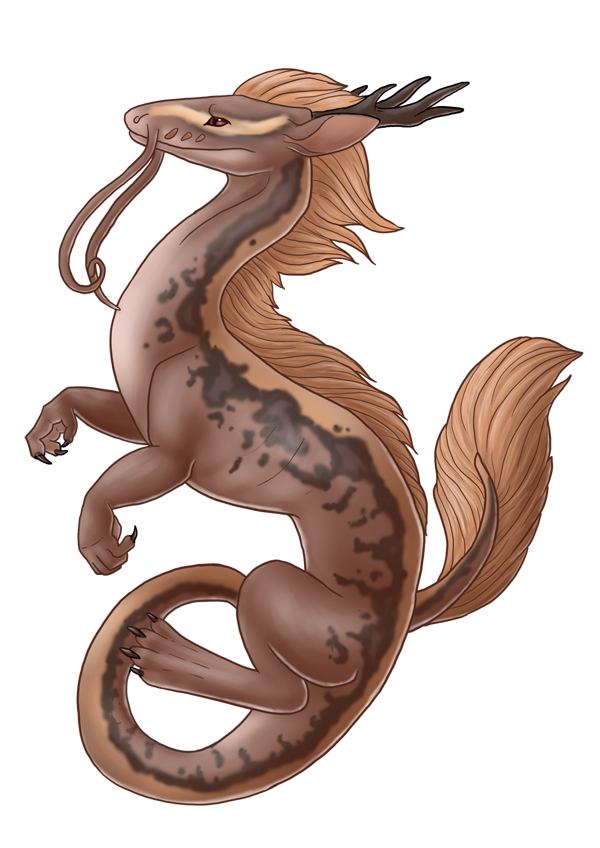

|
IMPERIAL LUUNG
Classification: Dragon, bonding-type
Homeworld: Giojsen Size: 5'-12' at shoulder Clutch Style: Oviparous Diet: Omnivorous |
GENERAL
Luungs are large, 4-legged, wingless dragons covered in very soft serpentine scales with a ridge of hair along their spines. They have long, highly flexible whiskers that are used as a sense-organ to ‘taste’ their environment by picking up trace chemicals. Luungs have long, serpentine bodies and comparatively short legs.They come in a myriad of colors and patterns, consisting of brown, yellow, grey, black, and white. Their eyes are large and luminous with slit pupils.
Standard luungs are between 5’-12’ at the shoulder, with lengths 7-10x their height.
Pygmy luungs are a recessive mutation, which can show up in clutches produced by standard parents. Pygmies are generally 2’-3’ at the shoulder, with lengths 3-5x their height.
Females of both variations are larger than their male counterparts.
Luungs are mmnivorous, with a heavy preference for meat, fruit, eggs, and fish. They cannot digest grain or dairy products, and most detest vegetables.
LIFESPAN & REPRODUCTION
Luungs are a long-lived race, who can reach well over 300 years before succumbing to old age.Luungs do most of their growing in the first few years of life, reaching sexual maturity and 80% of their full size within the first 3 years.
Clutch size varies between 3 and 8 eggs.
Luungs are oviparous, an egg-laying species. They form strong emotional attachments to their mates but are rarely monogamous. Naturally, luungs only produce a handful of clutches during their long lifespans. This is one of the reasons the species’ numbers have declined and an issue the Refugium is attempting to correct through genetic modification. Females are significantly rarer than males, occurring at a rate of about 1:5.
Elaborate mating rituals to impress potential partners are commonplace for luungs. They use their slinky bodies and ability to float to perform dazzling, hypnotic dances in the air. Style and creativity appear to be the most attractive aspects of these dances, but some mates prefer feats of athleticism or strength.
Luung scale patterns and colors are passed down via a complex set of genetics. Genealogy is important to luungs, and many know what sort of colors and patterns they carry but do not express.
CLANS & NAMING CONVENTIONS
Ancestry is important to luungs and they reflect this in their names. The luungs who reside at the Refugium come from 5 separate lines, and each line has its own family name. Clan names come before given names. In the event that luungs from two different clans breed, the offspring will take the mother’s clan name.Given names are short and vowel heavy, consisting of 1-2 syllables. There is no difference between masculine and feminine names.
Clan Kimoke
Kimoke luungs tend to be smaller than the other families, possibly due to inbreeding in the ancient days. Kimoke luungs sport greyscale coloration and are often axanthic and/or piebald. Generally speaking, Kimoke luungs can be xenophobic to outsiders and may often sport haughty and vain personalities. Kimoke tend to be artistic and creative.Clan Runike
Runike luungs are average sized and typically come in bright shades of yellow. Pastel, albino, banana, and champagne are common morphs for this family. Runike luungs are known to be social and outgoing, with cheerful attitudes.Clan Iyafu
Iyafu luungs are large, but typically have shorter legs than the average luung. Their manes are also shorter and stiffer. The Iyafu clan are dark, carrying genes such as black pastel, mahogany, cinnamon, and clown. They are known to be calm, patient, and caring.Clan Oneya
Oneya luungs are slender and long, with bright eyes and mischievous temperaments. They are known for their varied patterns, and carry genes such as pinstripe, spider, genetic stripe, and highway.Clan Tayo
Mysterious and reserved, the Tayo clan are the least numerous but physically the largest of the remaining luung families. They are often pale in coloration, and sometimes solid white. Mojave, lesser platinum, and ivory are the most common morphs.MAGIC
All Imperial Luungs have the following abilities:
Drifting - the ability to fly/float through the air without physical wings
Telepathy - when bonded, share a telepathic mind-link with their bond
Verbal Communication - luungs are capable of replicating non-draconic speech, and pick up the verbal language(s) of their bond with ease
Lifespan Alteration - bonding with a luung will cause the bond’s lifespan to change, which typically lends itself to giving the bond an unnaturally long life
Clan-Specific Magic:
Water Breathing - the ability to breath underwater (Oneya, Iyafu)
Water Manipulation - the ability to control water (Oneya, Iyafu, Kimoke)
Weather Summon - the ability to summon cloud cover, rainfall, snowfall, or wind (Kimoke, Tayo)
Cold Resistance - the ability to survive extreme cold temperatures without harm or discomfort (Kimoke, Tayo)
Heat Resistance - the ability to survive extreme heat without harm or discomfort (Kimoke, Runike)
Air Manipulation - the ability to control wind currents and air density (Runike)
HISTORY
The luungs home planet is small and varied, with a cool climate that turns inhospitable at the poles. Ocean made up 90% of the planet’s surface and the rest consisted of varying islands and mountain ranges. Luungs were the dominant species, and their local bonding partners are a small, humanoid species the Aleran.The luungs were prosperous for millennia until a deep sea volcano erupted, producing highly resistant bacterial spores that affected both Luung and Aleran alike. Unbonded Aleran succumbed to extinction and those that remained became infertile. Many adult luungs also passed away from the disease, leaving a frail mature population and no bondmates for future clutches.
When the Refugium’s searchers discovered the planet, they rescued as many luungs as were willing to come with them. Now the majority of the population resides on the Refugium, hoping to create a new homeworld or find a way to destroy the mysterious bacteria that nearly wiped them out.